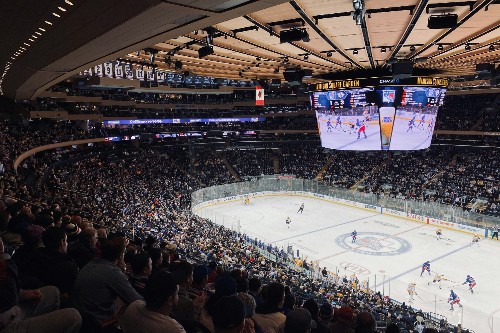A new study has exposed for the first time the vast proliferation of gambling marketing during live TV screenings and social media promotion of National Hockey League (NHL) and National Basketball Association (NBA) games in Canada.
The rapid assessment, undertaken by the University of Bristol in collaboration with Canadian Broadcasting Corporation (CBC) News, monitored gambling-related marketing during the NHL and NBA broadcasts shown on TV in Ontario and across social media for five days. Its findings uncovered concerning trends, highlighting the prevalence of the issue and need for greater regulation.
The research revealed more than 4,100 gambling messages spread over just seven NHL and NBA matches. Most of the gambling messages (93.9%) during the coverage were clearly visible on the playing surface or on advertising hoardings. More than a fifth (21.6%) of the total duration of live broadcasts contained gambling logos or references to gambling, according to the study, and only a tiny fraction – less than 3% – featured harm reduction or age restriction messages.
During a single NBA match, between Toronto Raptors and Chicago Bulls, 799 gambling messages were found. Almost half (48%) of the logged social media gambling adverts flouted an important national advertising regulation.
Co-lead researcher Dr Jamie Wheaton, Research Associate at the University of Bristol, said: “The sheer volume of gambling marketing shown during NHL and NBA games shows they are inescapable. Audiences, including children, are bombarded with logos widely visible, as well as studio coverage dedicated specifically to sports betting.
“This risks the normalisation of gambling as part of sports coverage, with hardly any acknowledgement made to the significant risks gambling poses.”
During the live TV coverage, a total of 3,537 gambling messages were recorded over the games broadcast on TV for around 21 hours during a five-day period between 25 and 29 October last year.
“The total duration of gambling messages being shown on TV averaged 39.8 minutes per match broadcast, including studio discussions. In other words, every hour of coverage included an average of 13 minutes that contained a gambling message,” Dr Wheaton added.
Broadcasts were shown to feature numerous sports betting markets, which appeared on-screen during the studio match commentary. TV sports presenters even discussed statistics related to key players within the match, which could be used by viewers to influence and optimise their bets.
Co-lead researcher, Dr Raffaello Rossi, Lecturer in Marketing at the University of Bristol Business School, said: “Incorporating discussions about sports betting into the broadcast content is extremely problematic, as it blurs the line between the broadcast content and marketing even further. This can generate the impression betting is a completely normal – and harmless – part of experiencing sport.
“It’s particularly worrisome, as many children and vulnerable groups watch NHL and NBA matches.”
Findings showed only 2.6% of gambling messages during the game broadcasts contained a harm reduction message, while only 2.8% of gambling messages contained age restriction messaging.
The study comprised broadcasts of two NBL and five NHL games in Ontario, as well as the analysis of 10 licensed gambling brand’s social media accounts. It used analysis models from previous research in the UK, which similarly found gambling messages saturate coverage of Premier League football.
The research in Canada also highlighted the growing potential of social media to reach large target audiences. Nearly half (48%) of social media adverts were not clearly identifiable as advertising, which breaches a key Canadian Code of Advertising Standards regulation. Almost everyone (98%) who featured in the adverts were men, with four out of five (79%) aged 18-34 years old.
“Our study highlights a serious issue with social media gambling marketing, notably content marketing. There is an urgent need to strengthen regulations to protect consumers – in particular children, who are especially vulnerable to such sneaky advertising techniques,”Dr Rossi added.
Commenting on gambling advertising rules in Canada, Dr Wheaton said: “We believe current regulations in Ontario lack the ability to effectively control the volume and format of gambling marketing found during these sports. Regulations should go further to ensure audiences are protected from excessive levels of gambling marketing.”
The report stresses the urgent need for international collaboration to help tackle the issue, exacerbated by an upsurge in online gambling platforms.
Dr Rossi said: “Unlike mature regulations in jurisdictions with years of legal online sports betting, Ontario’s regulatory framework feels somewhat immature. This poses a significant challenge, as the gambling industry, with giants like FanDuel, Betfair and Skybet, being part of one huge multinational cooperation with extensive experience operating in multiple jurisdictions.
“Countering their knowledge with new regulations is nearly impossible. So we need to join forces and foster much greater international collaboration to effectively regulate betting practices.”
Last year the University of Bristol launched the Bristol Hub for Gambling Harms Research to lead pioneering multidisciplinary research into the wide-reaching effects of gambling harms.
The independent hub facilitates world-leading research to improve understanding of gambling harm as a growing public health issue which needs greater scrutiny and regulation.

